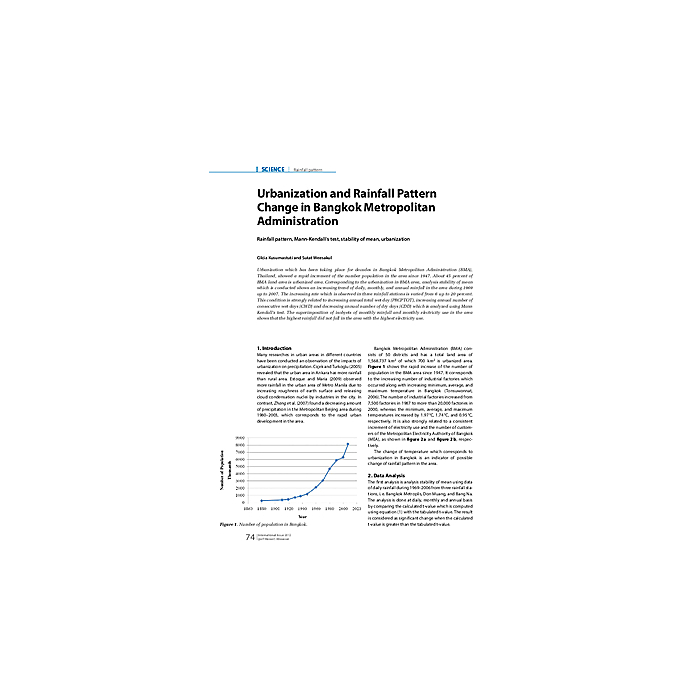Urbanization and Rainfall Pattern Change in Bangkok Metropolitan Administration
4,90 €
Auf Lager
Artikelnummer
05399_2012_SP1_09
Urbanization which has been taking place for decades in Bangkok Metropolitan Administration (BMA), Thailand, showed a rapid increment of the number population in the area since 1947. About 45 percent of BMA land area is urbanized area. Corresponding to the urbanization in BMA area, analysis stability of mean which is conducted shows an increasing trend of daily, monthly, and annual rainfall in the area during 1969 up to 2007. The increasing rate which is observed in three rainfall stations is varied from 6 up to 20 percent. This condition is strongly related to increasing annual total wet day (PRCPTOT), increasing annual number of consecutive wet days (CWD) and decreasing annual number of dry days (CDD) which is analyzed using Mann Kendall's test. The superimposition of isohyets of monthly rainfall and monthly electricity use in the area shows that the highest rainfall did not fall in the area with the highest electricity use.
| Autoren | Cilcia Kusumastuti and Sutat Weesakul |
|---|---|
| Erscheinungsdatum | 30.06.2012 |
| Format | |
| Zeitschrift | gwf - Wasser|Abwasser - Special 1 2012 |
| Verlag | DIV Deutscher Industrieverlag GmbH |
| Sprache | English |
| Seitenzahl | 4 |
| Titel | Urbanization and Rainfall Pattern Change in Bangkok Metropolitan Administration |
| Beschreibung | Urbanization which has been taking place for decades in Bangkok Metropolitan Administration (BMA), Thailand, showed a rapid increment of the number population in the area since 1947. About 45 percent of BMA land area is urbanized area. Corresponding to the urbanization in BMA area, analysis stability of mean which is conducted shows an increasing trend of daily, monthly, and annual rainfall in the area during 1969 up to 2007. The increasing rate which is observed in three rainfall stations is varied from 6 up to 20 percent. This condition is strongly related to increasing annual total wet day (PRCPTOT), increasing annual number of consecutive wet days (CWD) and decreasing annual number of dry days (CDD) which is analyzed using Mann Kendall's test. The superimposition of isohyets of monthly rainfall and monthly electricity use in the area shows that the highest rainfall did not fall in the area with the highest electricity use. |
Eigene Bewertung schreiben


